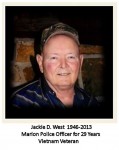 Lack Bradley “L.B.” Hunter, Marion Chief of Police from 1968 to 1985, was born June 21, 1930, in Marion to George Hunter and Lelle Bradley on N. Madison Street. Hunter attended Marion schools and graduated Marion Township High School. His father, George Hunter, was a full blooded Scotsman who came to America in 1902 to work the local coal mines.
Lack Bradley “L.B.” Hunter, Marion Chief of Police from 1968 to 1985, was born June 21, 1930, in Marion to George Hunter and Lelle Bradley on N. Madison Street. Hunter attended Marion schools and graduated Marion Township High School. His father, George Hunter, was a full blooded Scotsman who came to America in 1902 to work the local coal mines.
When the 1930 census was taken, the Hunter family was living at 913 N. Madison Street which they owned and valued at $2,000. George and Lelle were both 33 and their only child, Lack, was an infant. George was working as a coal miner for the Wallace Coal Company. Continue reading




